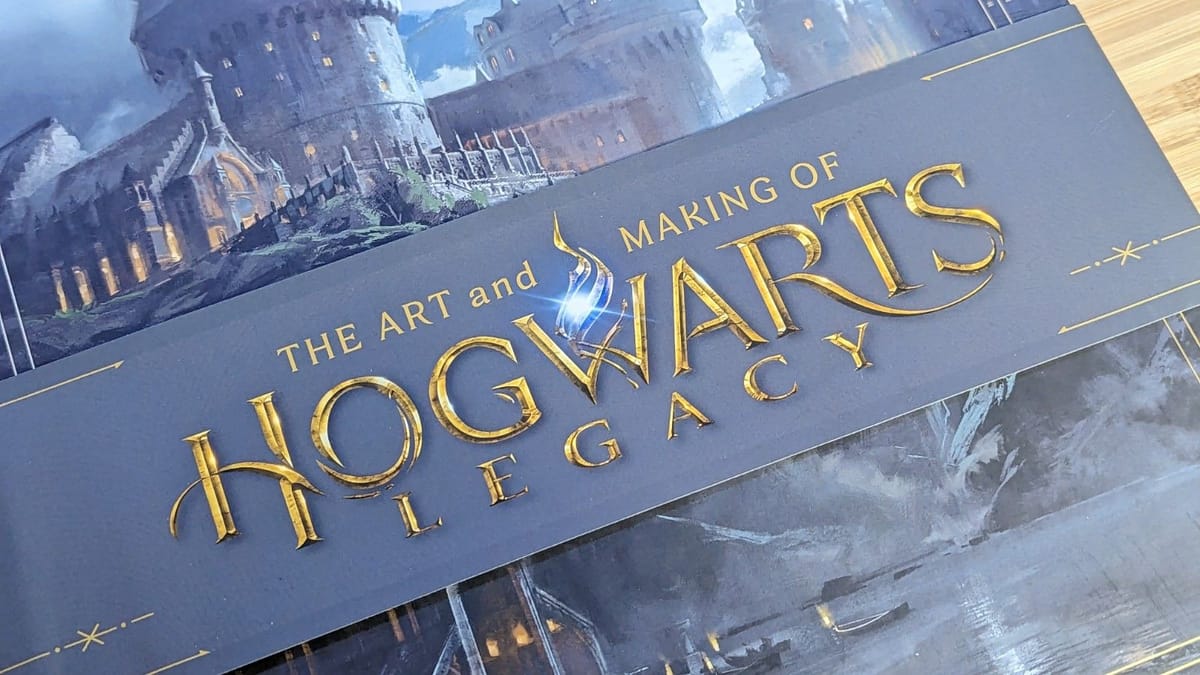
Hogwarts Legacy was a runaway hit so big that even Warner Bros. was caught off guard. To date it has sailed past 15 million copies, or 256% of what was expected. Our review reflected that with the simple declaration “I love magic”, and a near-perfect score of 95%. Now we’ve gotten our hands on The Art and Making of Hogwarts Legacy: Exploring the Unwritten Wizarding World from Insight Edition, and it should come as no surprise that this book is just as magical as the game it reveals. Let’s open it up and see how it was brought to life.
At 252 pages, this hardbound book is HEAVY. The binding on it is sturdy, featuring the majesty of Hogwarts School of Witchcraft and Wizardry. Insight did something cool and subtle to make it even taller as this book is almost an inch taller than any of their other books. It makes it stand out, and it’s a slick illusion that you might not notice until it’s side by side with other books from the publisher.
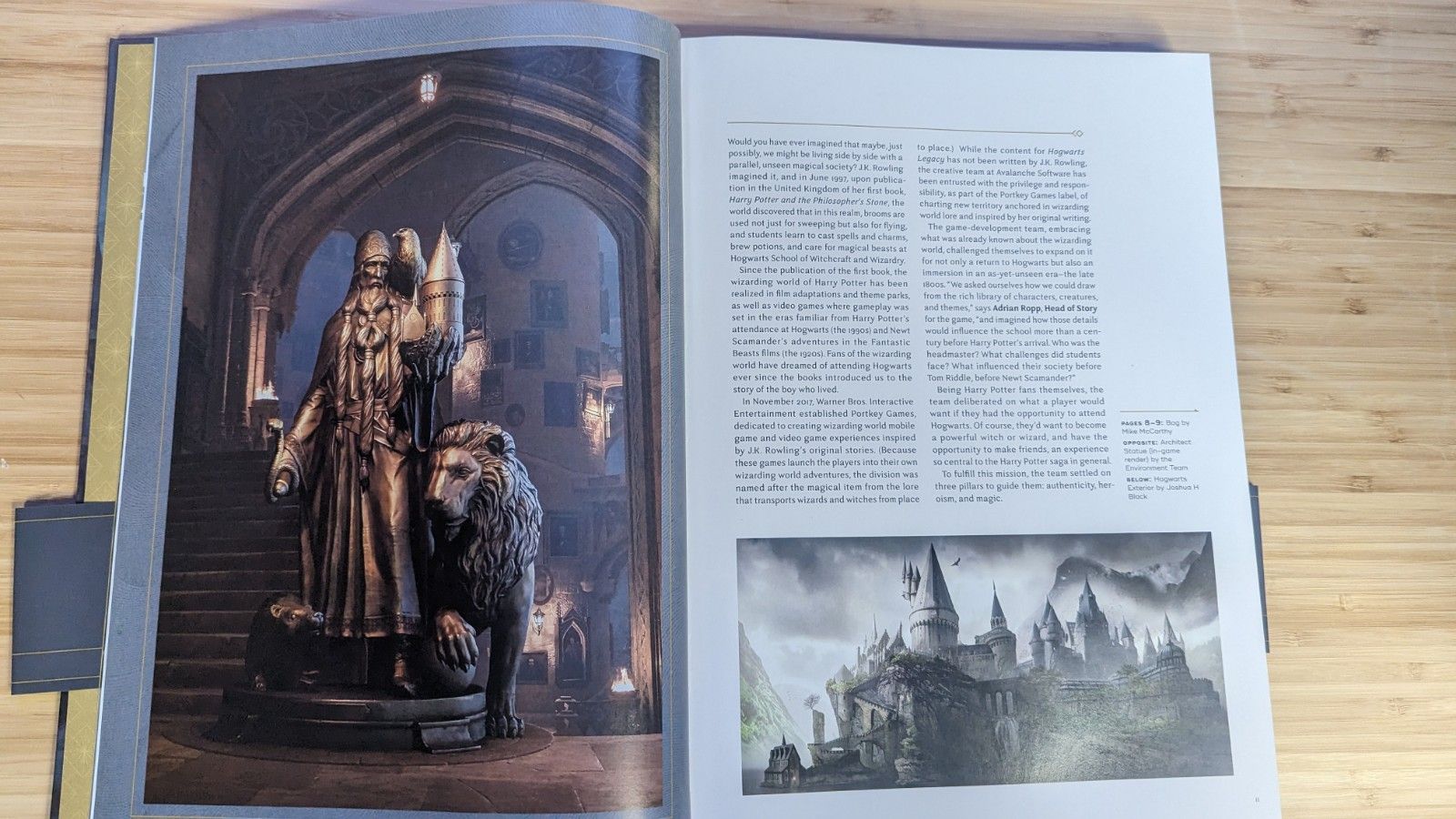
The book is broken up into five chapters, with a section called “Continue Play” and “Acknowledgements” following at the end. Kicking things off is a Foreword by Jeff Bunker, the Art Director for Portkey Games, and the leader of the team behind all of this amazing artwork. In it we get his thoughts about the challenge of bringing not only the parts of the Wizarding World we’ve seen in the films to life, but also the spaces in between. It’s immediately clear that Jeff is a massive fan of the property, and his passion and enthusiasm come through clearly.
Chapter one is called “The First Mission” and as you can probably infer, it’s all about how you start off in the game. Right out of the gate we get to see an excellent in-game render of the Architect of Hogwarts, a wizard from circa 993 who worked with Rowena Ravenclaw to design the ever-changing floorplan of Hogwarts, as well as the walls that would contain it. In the pages that follow, Narrative Lead Moira Squier talks about how the team approached authenticity, grappling with questions that the books simply did not answer. Things like whether Graphorns are omnivores, or asking how long a house elf lives helped form the living world of the game. Here they are brought to life with some beautiful hand-painted artwork.
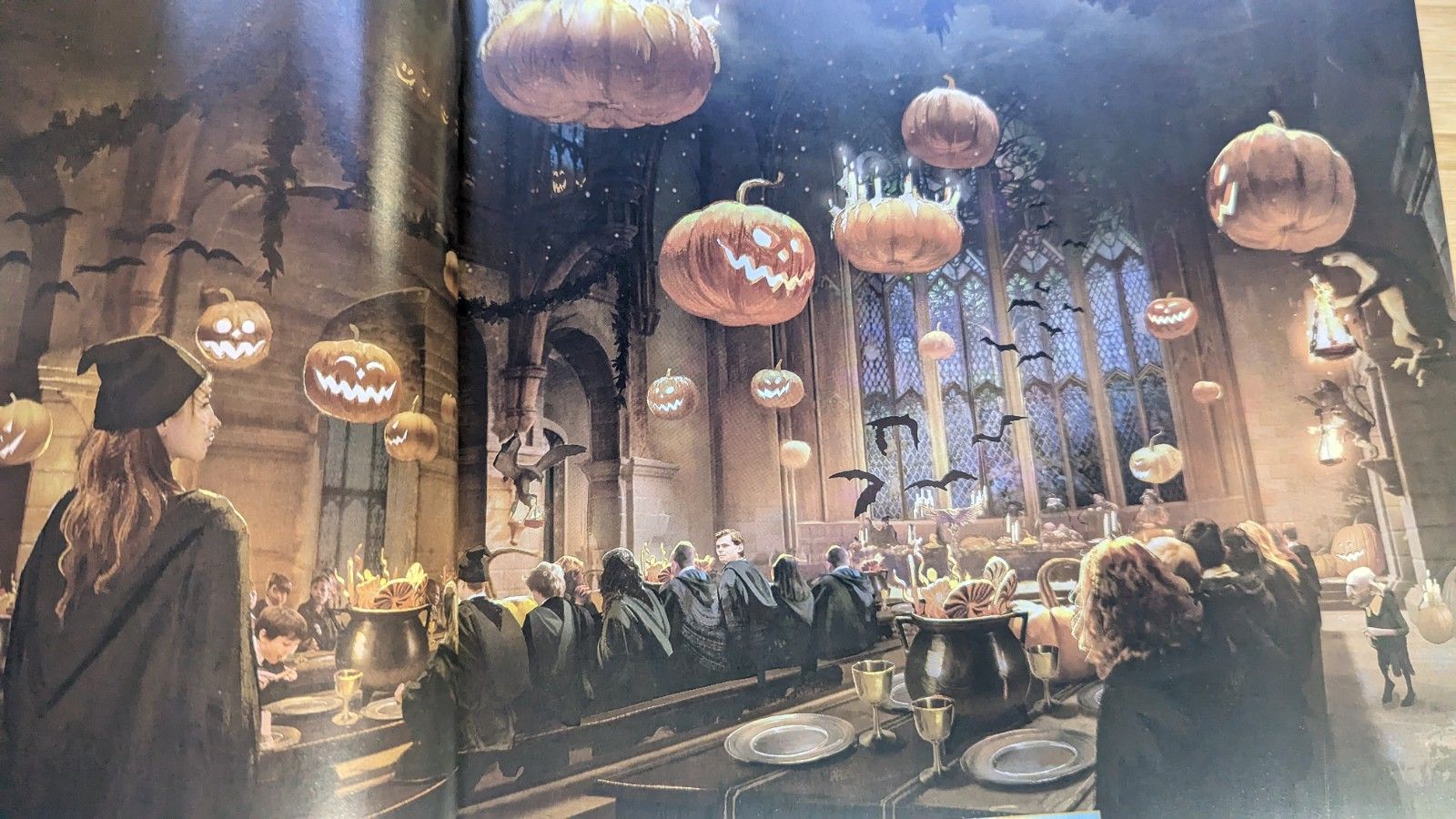
One of my favorite themes in the game is tackled directly in chapter one as well – heroism. The game casts you as a reluctant hero, put in the middle of a dark conspiracy that is so much bigger than they are. Throughout the story the player grows in power and skill, and they are given opportunities to grow into the impossible role of hero. That means exploring the dark and scary places beyond the safety of the castle – exactly as we see it depicted in this book in a blend of renders, concept art, and paintings. These paintings perfectly capture how the right environment can make the player feel small as they fight to overcome the dangers ahead.
Naturally, Hogwarts Legacy is all about magic, and a good chunk of this first section is devoted to the traditional wand waving magic, as well as the ancient magic you uncover throughout your journey. Simple things like “How do the pumpkins levitate in the Great Hall?” to the inner workings of the Ancient Magic Artifacts you uncover in the game are presented in an array of artworks and renders, flanked by in-depth discussions from the likes of Boston Madsen, the Hogwarts Art Lead and Sr. Artist for Environments.
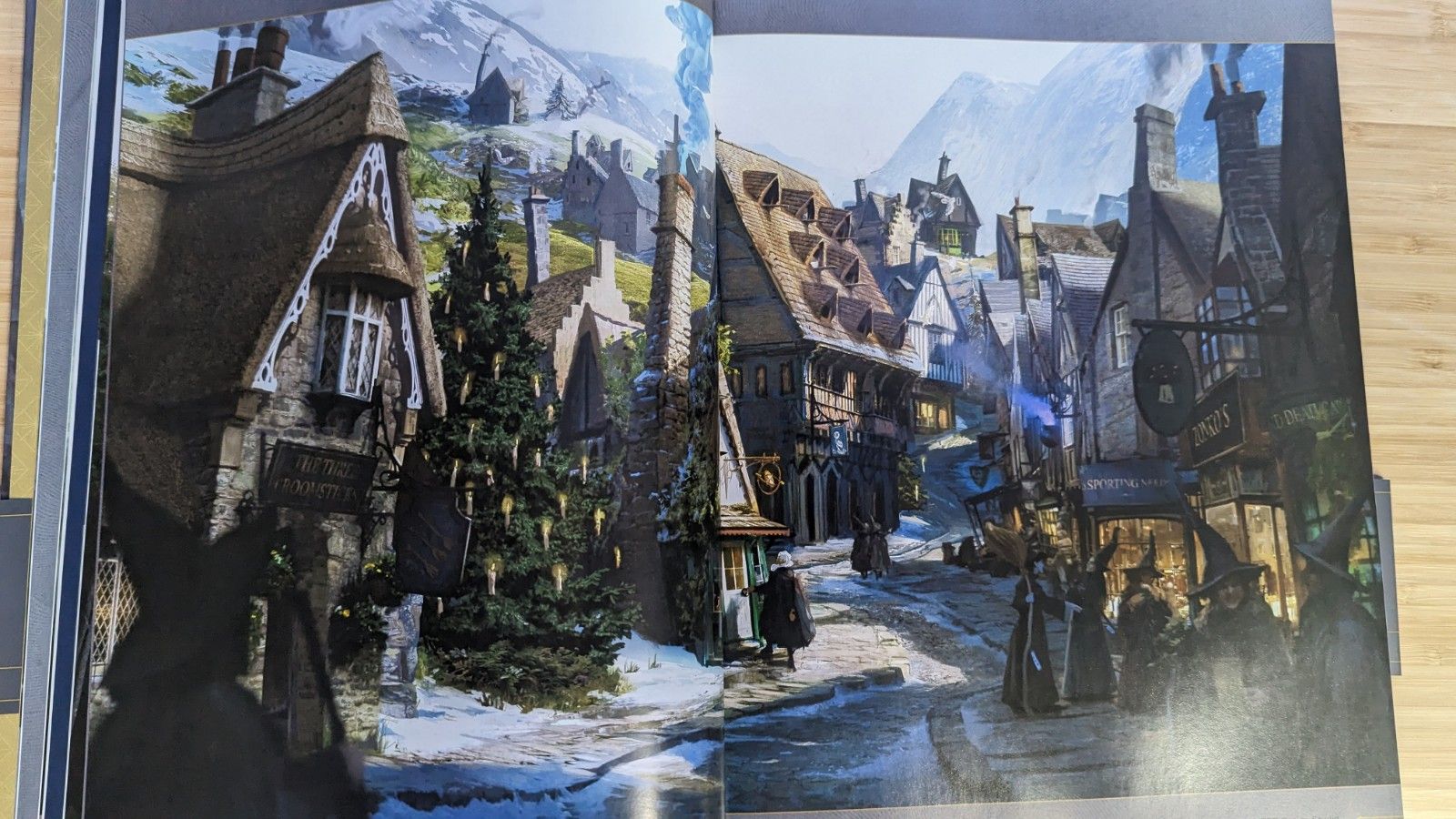
Chapter two is entitled “Where Our Story Starts” and it kicks off with one of my favorite parts of Hogwarts Legacy – the wardrobe. Dressing the part is one of the best parts of the game, and we get to see Characters Art Lead Tyler Lybbert and his team’s work right out of the gate, with 12 awesome renders of complete outfits from Vanessa Palmer, and an intricate fully-realized character provided by Danny Russon.
Bringing Hogwarts to life must have been a daunting task, but filling in the spaces not described by the book could have been delightfully freeing. How far is it really from Hogwarts to Hogsmead? We know the kids in the books walked there, but how long did that really take? How far to the next town in any direction? How deep are the caverns in the lake? The Environmental team at Portkey Games got to do exactly that.

Populating all of these locations means creating a whole host of characters. Peeves, Gerbold Ollivander, Headmaster Black – all of them get some intricately detailed character art, with Ollivander getting a full layout from concept to fully rendered in stages. There are several more from Concept Art Lead Sébastien Gallego and Vanessa Palmer. The Victorian one is the stuff of nightmares – thanks guys!
One of your most steadfast companions is Professor Eleazar Fig, a Gryffindor in charge of Magical Theory, but he’s hardly the only teacher you’ll meet at Hogwarts, of course. Here we get a full dossier as well as some renders for all of them. My favorite, however, is that of Professor Mirabel Garlick – your Hufflepuff Herbology instructor. Artist Joshua Black brings her to life with this super stylized drawing that conveys every bit of her personality as it comes to life in the game – you can’t help but like her. All of these character portraits, especially the super stylized ones, show just how much thought the Portkey team put into each of them, friends and foes alike. Even minor characters that you might only interact with once are fully realized, and that comes across in the game in a big way.
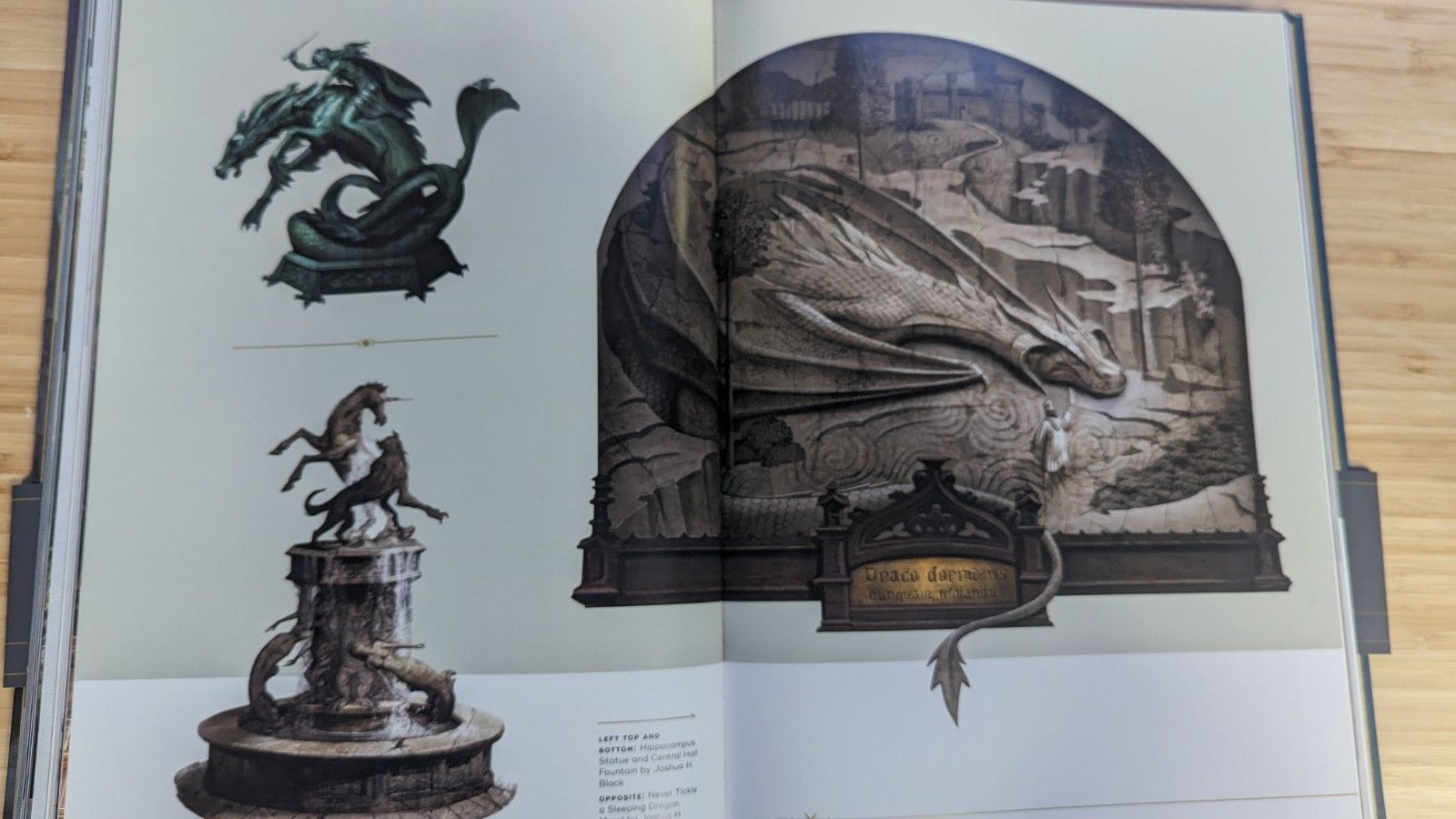
Chapter 3 is called “Establishing the Locations” and it’s about, you guessed it, the various locations you’ll visit in Hogwarts Legacy. Dungeon Design Lead Andrew Hayes and Art Director Jeff Bunker talk through how the superfans on the team were able to bring all of these places to life, showcasing the massive amount of variety that ended up reflected in the game. Beaches, mountains, forests, ruins, and the Dark Forest are joined by spider-infested caves. Turning to interiors, the team also extended that enthusiasm to the classrooms, castle, rustic villages, and eventually, the Room of Requirement. It’d be one thing to simply trim the space in high ceilings and various woods, but it’s the detail that’s tucked into every corner that makes Hogwarts what it is. Even in the books the space is described in a way that suggests it’s packed to the rafters with stuff. Tapestries, drawings, specimens, and various learning implements dot every square inch of the space. Some instructors are fastidious, keeping a tidy classroom. Others are more chaotic, leaving stacks of books to be used as tables and shelves. The team replicated what was in my head perfectly, and we see those elements spelled out in great detail here.
One of the collectibles in the game is, frankly, knowledge. Throughout the castle lie a number of statues. These are often important figures in wizarding history, or depict aspects of everyday magical life. What makes them worth collecting is that each of them carry some tidbit about why that statue is important. Whether it’s a funny story, a historic moment, or a funny anecdote that serves as a cautionary tale, you’ll find these with the spell Revelio. I don’t normally chase down every collectible in a game, but I had to have every one of these. In this art book, we see some of them in incredible detail, including a personal favorite – the fountain that sits outside of the library.
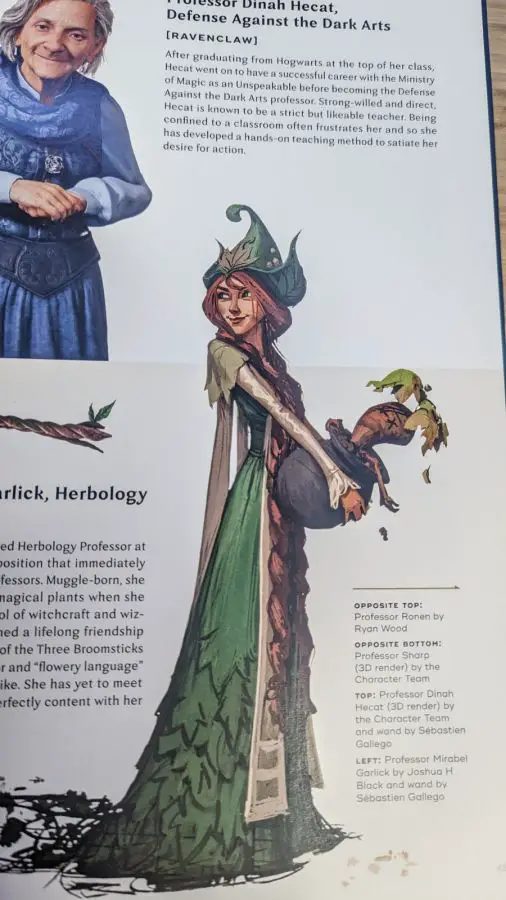
One of the areas that I feel would be great to expand would be the player’s bedroom. There wasn’t a great deal of reason to return to your sleeping space in Hogwarts, but that didn’t stop the team from spending a great deal of effort to make it amazing. In the films we see some shots of magical dorm life, and the team looked to recreate some of that here. We see some concept sketches of various objects that would be tucked into the room, as well as Fig’s living quarters, as an example.
Outside of the bedrooms lie the common rooms, and you’ll visit these periodically. It’s another area that could use a little more love, gameplay wise, but it’s very clear that the art team certainly put a TON of thought into them. Each one of the four houses sees a massive amount of effort to ensure they all feel very different from one another. The greens and dark corners of the Slytherin common room artwork is a personal favorite here.
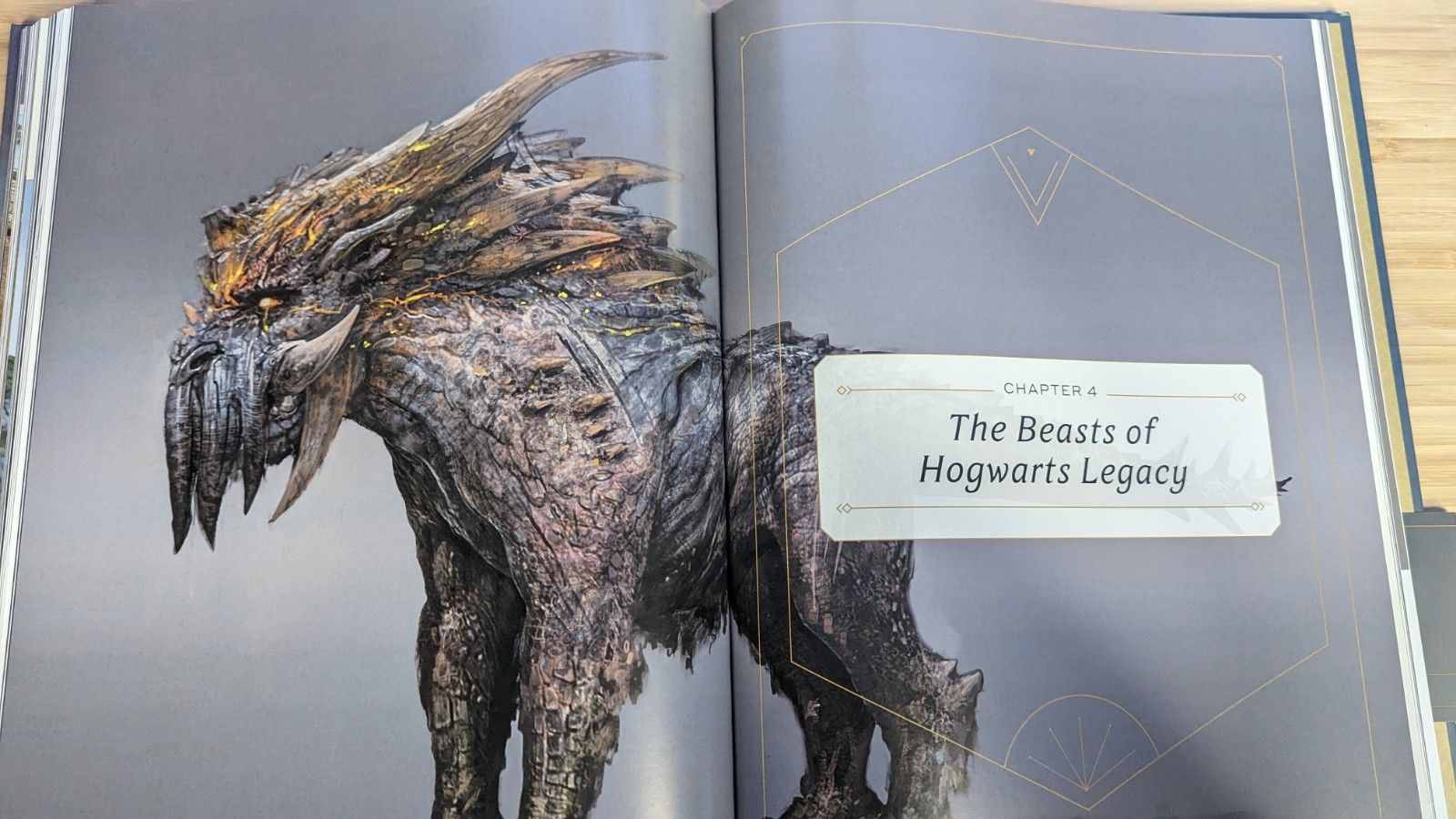
Once you unlock the Room of Requirement you’ll spend a lot of time there. In it you’ll have full control of customization, as well as the opportunity to breed beasts, grow ingredients, upgrade components, and brew potions. It’s very cool to see the components needed to do all of those things spelled out here, with some true attention to detail given to the plants. Each look like they have unique properties, and you can imagine them coming together to create things like the Thunderbrew Potion.
Hogsmead is a big part of the Harry Potter books, and they are a massive part of Hogwarts Legacy. You’ll visit early and often, and it becomes a home away from Hogwarts at times. As such, the art team has given Insight a ton of awesome artwork to share about what that space could look like beyond what we saw in the films. Scrivenshaft’s Quill Shop, Dervish & Banges, Dogweed and Deathcap, Brood & Peck – they all get the royal treatment. The pieces showcasing the interior and exterior of Ollivanders wand shop from Artists Danny Russon and Adam Tolman were pulled directly from my imagination, as if by magic!
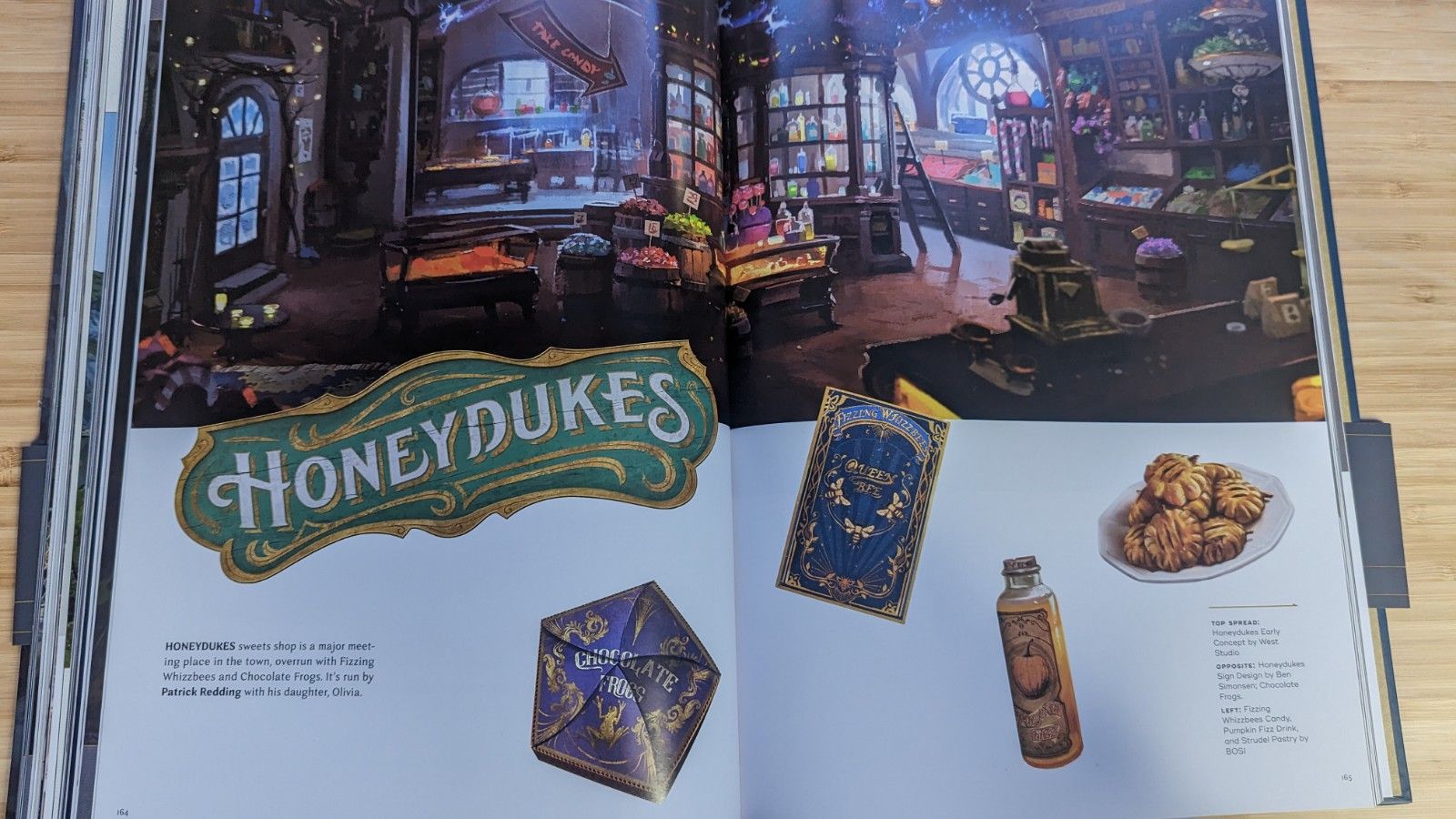
One of my favorite places in Universal Studios, be it Florida or California, is Honeydukes. The Universal team brought it to life for real, and I see some of that inspiration spilled over here. Chocolate Frogs, Fizzing Whizzbees Candy, Pumpkin Juice, and all manner of strange candies can be found here, and the team really flexed their imaginations bringing it to life in the game. Nearby is another staple of any visit to Hogsmead – The Three Broomsticks – Butterbeer, friends, and food! On the walls of both places are posters that are reminiscent of those in the 40s, with a hand-drawn style, but with a magical flair. If you were wondering if somebody advertised Gillyweed Tonic, the answer is yes!
Chapter 4: The Beasts of Hogwarts Legacy is…ok, the joke is old by now, but you guessed it – beasts. While the Portkey Games team clearly loved bringing Hogwarts to life, there’s an obvious affinity for making compelling (and often gross) magical monsters and beyond-cute beasties to sprinkle throughout the world. I dare you to not say “Awww!” the first time you see a Mooncalf baby. Well, thanks to this book you can also add “OH!! What in the world is THAT?!” as you can now see two of the earliest sketches that weren’t so cute. Seriously – the stuff of nightmares, folks. Further into this chapter we see other early sketches of Phoenixes, Puffskeins, Diricawls, Nifflers, Golden Snidget, Hippogriff, Gnomes, Dugbogs,, and much, much more. These behind-the-scenes are why I buy these books in the first place, making this another favorite section. I will make the suggestion to steer clear of page 208 to 211, however, as that might spoil some surprises in the game.
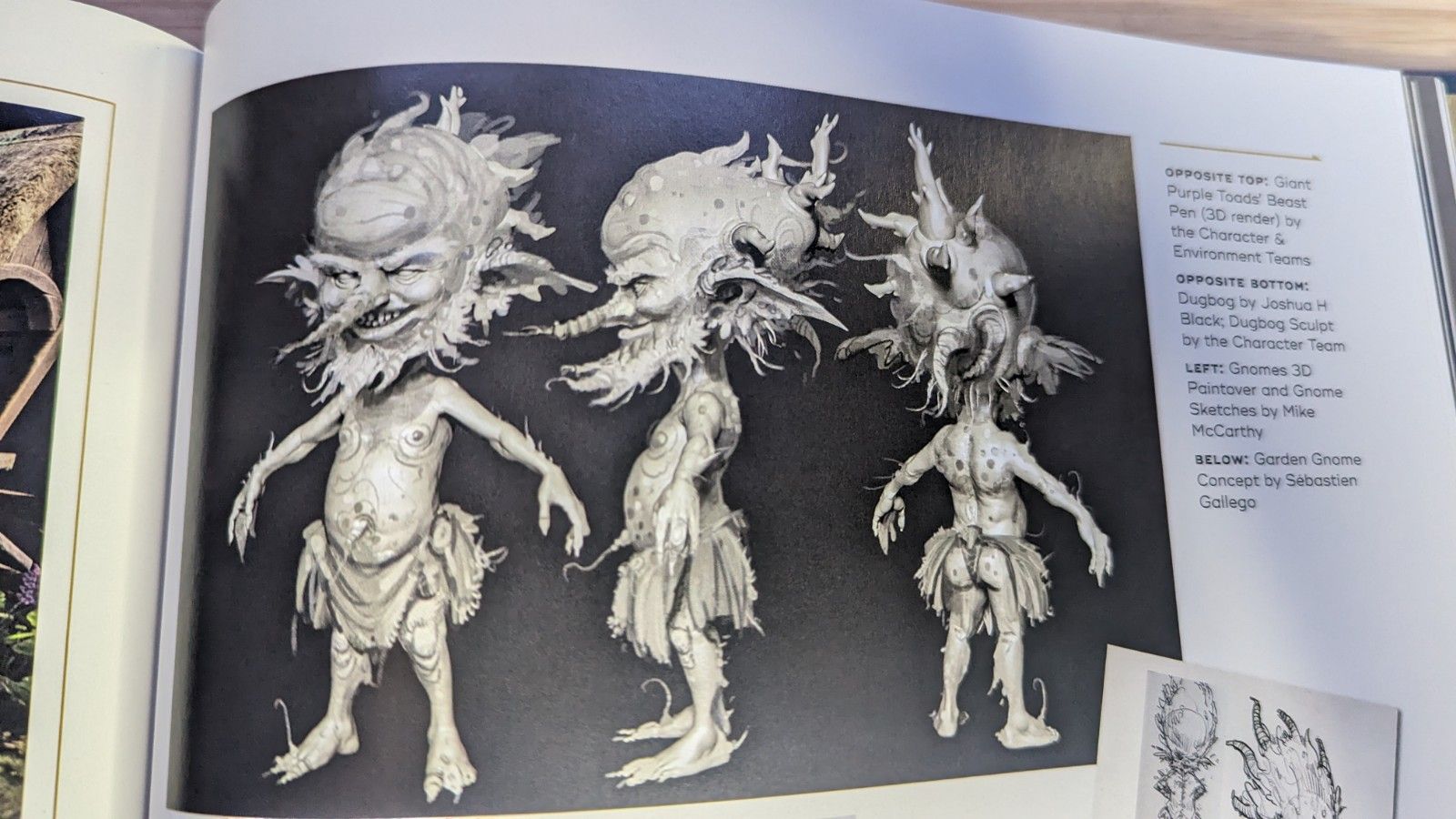
Chapter 5: Golden Paths and Dark Mysteries talks in detail about the main story and side missions of the game. In it we have a great deal of information from the development team about player choice, spellcasting, and allowing for as much freedom as possible. Dungeon design, puzzles, and how the team allowed for player growth beyond just shuffling numbers around gets a great deal of attention, flanked by some gorgeous schematics for spaces, artwork of how the player growth arc can look, and a few exotic locations. As such, please steer clear of page 238 to 247 as it contains minor and major mid to endgame spoilers.
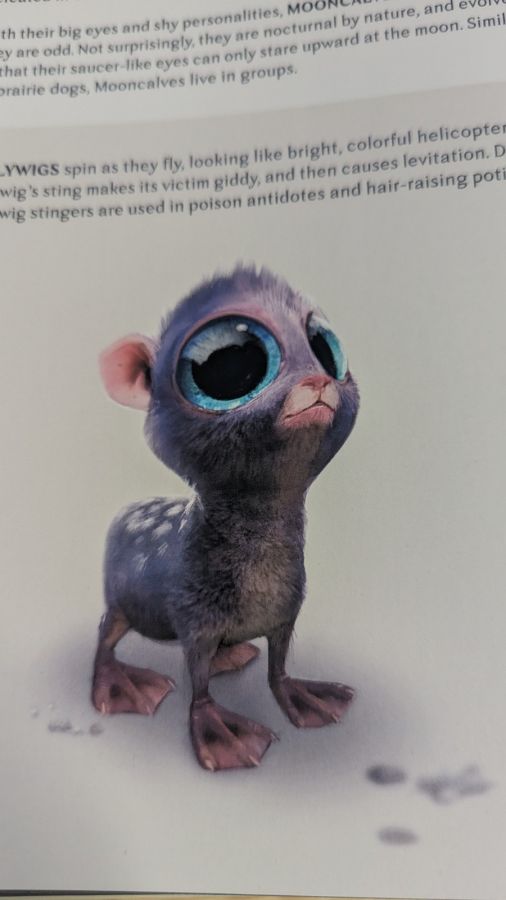
The last sections, Continue Play and the Acknowledgements are actually worth checking out. Head of Story Adrian Roop gives us his thoughts on the challenges and responsibilities in expanding one of the most beloved franchises of all time. Avalanche Software and Portkey Games truly did something magical, and based on the incredible reception it received, one we can hope to see grow even more. The Art and Making of Hogwarts Legacy: Exploring the Unwritten Wizarding World may be the longest book title I’ve seen in recent memory, but it truly is a wonderful companion for would-be wizards and muggles alike.
The Art and Making of Hogwarts Legacy: Exploring the Unwritten Wizarding World
Phenominal
Cast Accio and get yourself a copy of this book. Whether you have received your Hogwarts letter or if you are still tucked under the cupboard waiting for it, the Art and Making of Hogwarts Legacy: Exploring the Unwritten Wizarding World is the perfect companion to this ever-expanding universe.
Pros
- Great illusion to make the castle “bigger”
- 252 pages of incredible artwork
- EXTENSIVE amounts of information from the team
- Love the concept art throughout
Cons
- None!
